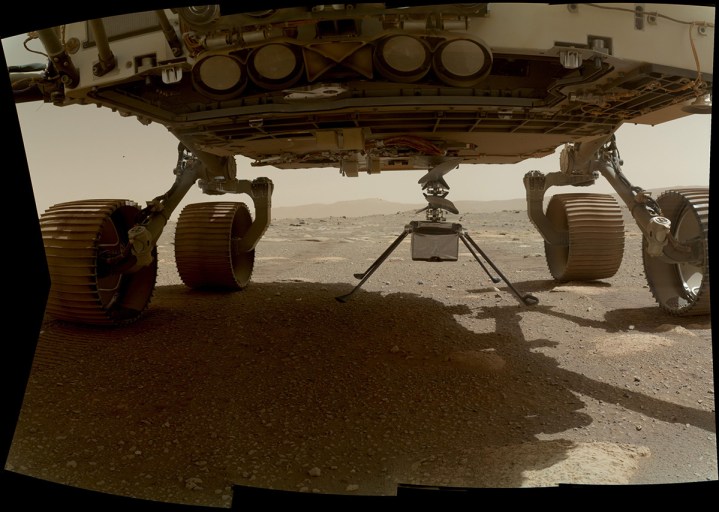
The highly-anticipated first flight of the Mars helicopter Ingenuity is fast approaching, and NASA personnel are busy getting the helicopter ready. The tiny Ingenuity helicopter has been tucked beneath the belly of the Perseverance rover up until now, but has recently been deployed by the rover and is now sitting on the Martian surface. The current aim is for Ingenuity to take its first flight next week on Sunday, April 11.
In a post from the NASA Jet Propulsion Laboratory Twitter account, engineers confirmed that Ingenuity has made its final 4-inch drop from the rover and has touched down safely on the surface of the planet. The concern now is keeping the helicopter warm enough over the frigid Mars nights so it can be ready for its test flight.
#MarsHelicopter touchdown confirmed! Its 293 million mile (471 million km) journey aboard @NASAPersevere ended with the final drop of 4 inches (10 cm) from the rover's belly to the surface of Mars today. Next milestone? Survive the night. https://t.co/TNCdXWcKWE pic.twitter.com/XaBiSNebua
— NASA JPL (@NASAJPL) April 4, 2021
NASA gave more details about how Ingenuity will keep itself warm in a blog post about the helicopter published on Friday, March 2: “Until now it has been connected to the Perseverance rover, which allowed Ingenuity to charge its battery as well as use a thermostat-controlled heater powered by the rover. This heater keeps the interior at about 45 degrees Fahrenheit through the bitter cold of the Martian night, where temperatures can drop to as low as -130F. That comfortably protects key components such as the battery and some of the sensitive electronics from harm at very cold temperatures.”
To prepare for separation from the rover, the helicopter’s batteries were charged to 100%. That way, the helicopter can run its heater to keep itself warm. With the helicopter now on the surface, the rover moves away to allow the rays of the sun to strike Ingenuity’s solar panels to keep its battery topped up and to keep it toasty.
The NASA blog gave more details about what to expect over the next few days: “The Ingenuity team will be anxiously waiting to hear from the helicopter the next day. Did it make it through the night? Is the solar panel working as expected? The team will check the temperatures and the battery recharge performance over the next couple of days. If it all looks good, then it’s onto the next steps: Unlocking the rotor blades, and testing out all the motors and sensors.”



